With the launch of the PlayStation 5 and Xbox Series X|S, AMD has been able to re-establish a footing in the conversation around high-end graphics processing. All that talk about RDNA 2 GPUs put the company in the spotlight, and its efforts amounted to some powerful next-generation gaming consoles. Both the Radeon RX 6800 XT and RX 6800 video cards bring the power of the RDNA 2 architecture to PC gaming and, based on our results, they make really strong cases for PC enthusiasts to consider AMD--which is something that we haven't earnestly said in quite a long time.
It's tricky, though. Nvidia has been breaking ground since 2018 with its RTX GPUs that integrate hardware-based solutions for ray tracing and AI-driven graphics tech. Over two years, we've seen developers gradually adopt real-time ray tracing in games for photorealistic lighting, shadows, global illumination, and reflections. The cut in performance while using these features can be significant but ray tracing has made strides since its introduction into mainstream gaming. The growing support for DLSS (deep learning supersampling) makes 4K image quality and ray tracing feasible while keeping frame rates high, too. In regards to innovation, Nvidia remained untouched. While AMD put out some solid mid-range cards with the RX 5000-series in that time, it wasn't able to challenge Nvidia at the high-end.
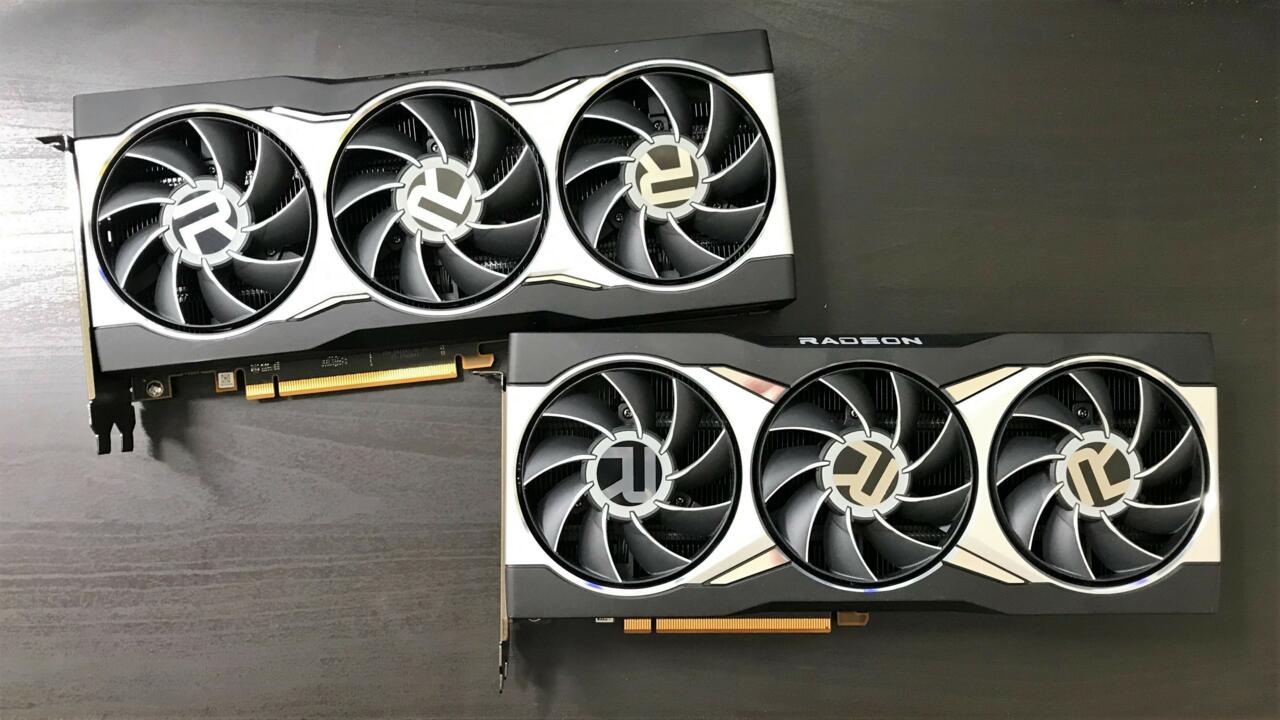
That changes with the launch of the RX 6800 XT and RX 6800. When it comes to raw performance metrics, AMD's new cards are right up there with Nvidia's best, trading blows depending on the game and graphics settings--finally, some good competition. When considering the RX 6800 XT's suggested retail price of $650 USD (compared to the RTX 3080's price of $700), AMD really gives Nvidia a run for its money. And in many cases, the slightly cheaper Radeon RX 6800, which goes for $580 USD, comfortably positions itself between the Nvidia's RTX 3080 and RTX 3070, even encroaching on Nvidia's top-of-the-line card in rare instances. It's an impressive showing and it's exciting to see AMD make a comeback, but it also presents PC gamers with the tough question of how to spend that hard-earned video card money. Our benchmark tests should at least help with that.
Technical Details
When it comes to the RDNA 2 architecture, the advancement in performance boils down to efficiency. At least with the RX 6800 XT and RX 6800, the focus is on operating frequency to get more out of the GPU on a per-watt basis--basically, high clock speeds while having more efficient compute units are the key to how AMD's new cards achieve high performance. This approach also allows GPUs in the RDNA 2 family to scale easily (not unlike what you see between the Xbox Series X and the less-powerful Xbox Series S).
Another major advancement in the new Radeon video cards is the AMD Infinity Cache--it's a bit tough to explain, but it's basically how RDNA 2 GPUs achieve high performance memory bandwidth efficiently and as a way to complement traditional GDDR6 video memory. As AMD puts it, the Infinity Cache "allows fast data access and acts as a massive bandwidth amplifier." What you need to know is that this results in performance that previous AMD cards couldn't achieve.
AMD's solution to real-time ray tracing also differs a bit from Nvidia's. On AMD's RDNA 2 cards, each of its compute units are paired with ray accelerators, which pick up the workload for DirectX ray tracing (DXR) tasks. Nvidia's RTX cards, meanwhile, have dedicated RT Cores that solely focus on taking care of ray tracing tasks--it's a somewhat different means (and label) to the same end.
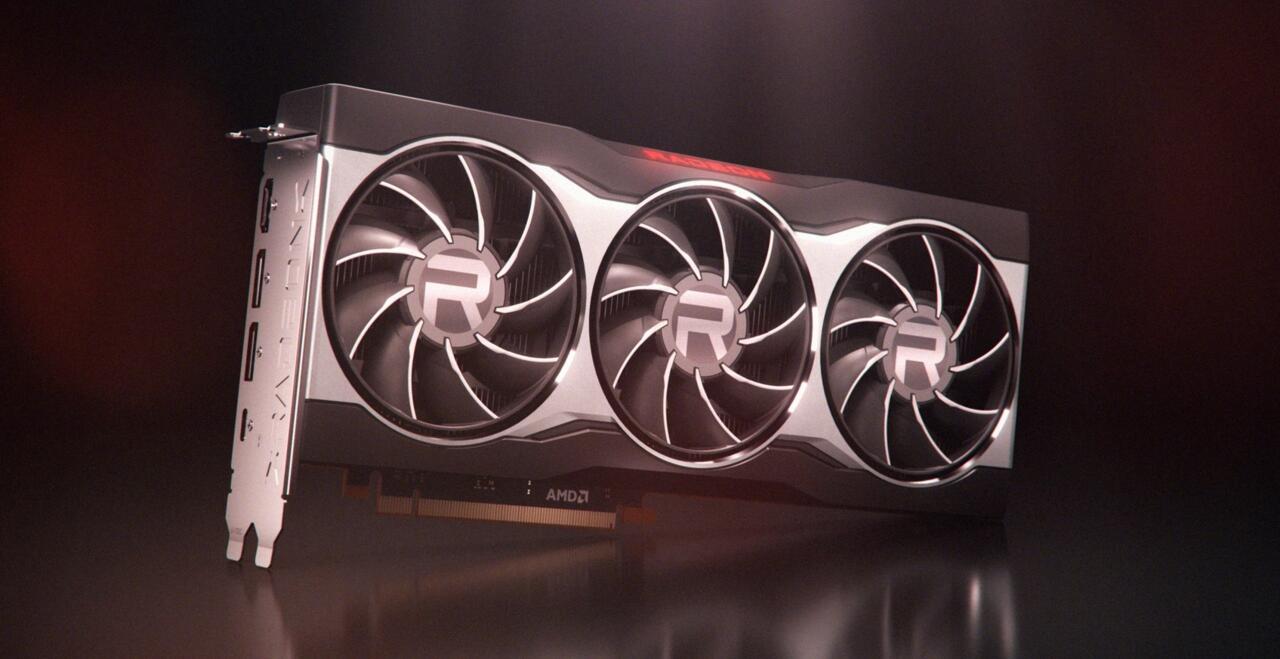
What AMD doesn't have is hardware-based AI processing like the Tensor core found in Nvidia's RTX cards. These cores are responsible for DLSS, a feature that creates native resolution image quality while using a lower base resolution to keep frame rates high and games looking sharp. It's a perk that only Nvidia offers and it's a boon at 4K. Although support for it is growing, only a handful of games can use DLSS. There isn't an AMD parallel right now, but it does have something in development that could be a similar solution. We simply don't know it'll pan out just yet.
There are AMD-only perks to consider, though. The most notable one is Smart Access Memory (SAM). If you pair an AMD Ryzen 5000-series CPU with a Radeon RX 6000-series GPU on a X570 or B550 motherboard with PCI-e 4.0, you can enable this feature. It's essentially a whole AMD ecosystem that fully utilizes the GPU memory and reduces system bottlenecks. Unfortunately, we're not equipped to test SAM ourselves, but AMD claims around an average of 6% increases in performance across different games. This is important for new system builders and current owners of Ryzen 5000-series CPUs--it's free frames-per-second. Though results will vary, this is value added for using AMD's ecosystem and an interesting perk to consider.
As for the RX 6800 XT and RX 6800 designs, both come with one HDMI 2.1 port, two DisplayPort 1.4 outputs, and one USB-C port. The 6800 XT is, of course, the beefier GPU of the two--it has more computer units, higher clock speeds, is physically bigger as a 2.5-slot card, and is rated for a 300-watt TDP. The RX 6800 is essentially a scaled-down version in all respects (although they both require two 8-pin power connectors). You can see the basic specs in the table below.
| AMD Radeon RX 6800 XT | AMD Radeon RX 6800 | |
|---|---|---|
| Compute Units | 72 CUs | 60 CUs |
| Stream Processors | 4608 | 3840 |
| "Game" Clock Speed | 2015 MHz | 1815 MHz |
| Boost Clock Speed | 2250 MHz | 2105 MHz |
| VRAM (GDDR6) | 16GB (+128MB Infinity Cache) | 16GB (+128MB Infinity Cache) |
| TFLOPs | 18.6 TFLOPs | 13.9 TFLOPs |
| TDP | 300 W | 250 W |
| Size | 10.5 inches, 2.5-slot | 10.5 inches, 2-slot |
| Price (MSRP) | $650 USD | $580 USD |
Methodology And Test Bench
For the purposes of this review, we used the same test bench as we've been using for the Nvidia RTX 30-series reviews. Although we've had access to limited resources given our working conditions, our setup represents a fairly high-end build that gives these video cards the opportunity to flex their stuff and using the same setup also keeps things consistent across our performance metrics.
- MSI Mag Z490 Tomahawk motherboard
- Intel Core i7-10700 (non-K) 8-core/16-thread CPU clocked at 4.7GHz
- Corsair H100i AIO Liquid Cooler
- 16GB (2x8GB dual-channel) Corsair Vengeance DDR4-3000 RAM
- Samsung 960 Pro 512GB NVMe SSD
- Seasonic Prime 1000W (80 Plus Platinum) PSU
We included two video cards from each manufacturer in our tests to compare and contrast their differences in performance: AMD's RX 6800 XT and RX 6800, and Nvidia's RTX 3080 and RTX 3070. For drivers, we used the beta version of Radeon Adrenalin 20.45.01.12 for AMD and Game Ready 457.30 for Nvidia.
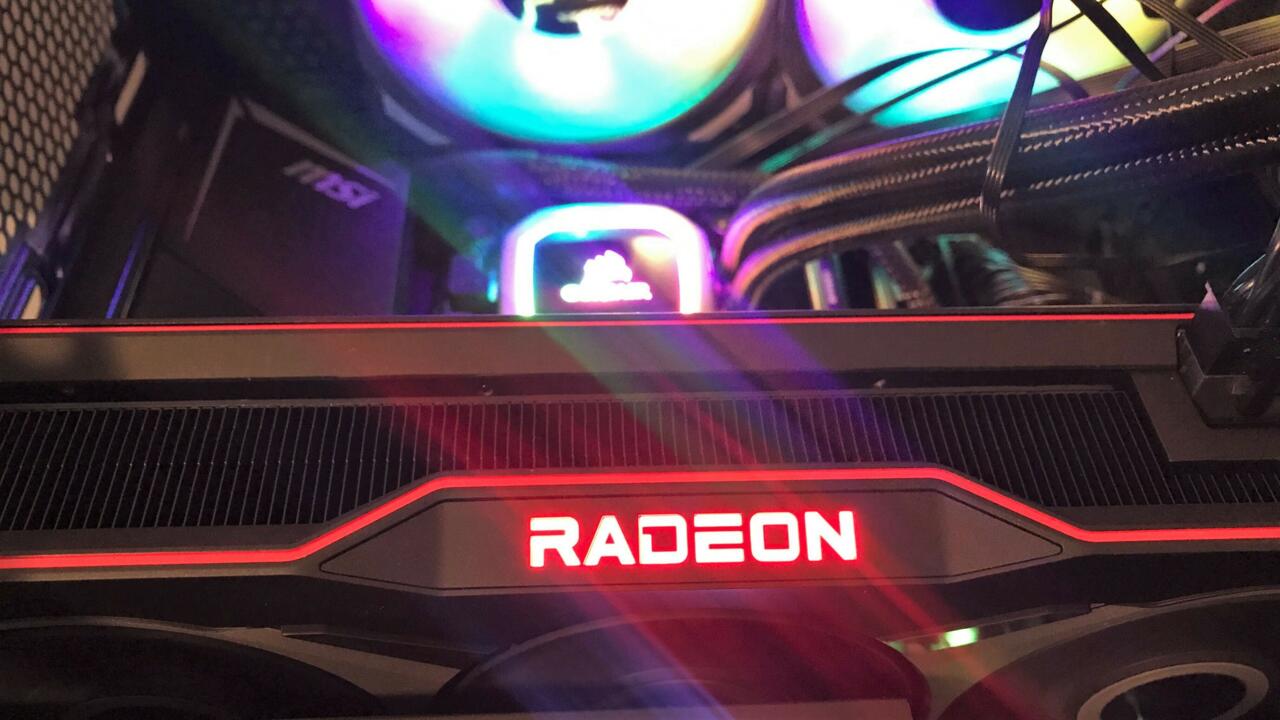
With AMD in the mix, we had to change up our benchmarking a little bit. Our previous tests also included the Nvidia-exclusive DLSS, which we can't use for comparative purposes (and we explain the impact in the following results). But to paint a clear picture of where AMD stands in regards to DirectX ray tracing, we used two major games: Metro Exodus and Control. We also used seven games with in-game benchmark tools to get basic performance metrics: Godfall, Assassin's Creed Valhalla, Red Dead Redemption 2, Dirt 5, Final Fantasy XIV, Horizon Zero Dawn, and Forza Horizon 4--contemporary games that represent the range of performance demands of PC games today. Our results focused on the average frames-per-second output, and since we're working with high-end video cards here, we used 4K and 1440p resolutions and maximum in-game graphics quality settings.
Benchmark Results
Everybody Loves Ray Tracing
To measure DXR performance for the RX 6800 XT and RX 6800, we used both Metro Exodus and Control with and without ray tracing enabled. These are two very demanding games, especially with the suite of ray tracing features cranked to the max. (Remember that you can always turn graphics settings down for better performance in real gameplay scenarios.)
Metro Exodus
When you max out every graphics setting, Metro Exodus really pushes video cards to their limit. With ray tracing set to "Ultra" and overall quality settings on "Extreme" (which isn't entirely realistic for gameplay purposes), top-end video cards will still struggle at 4K, but benchmarks do show off their capabilities.
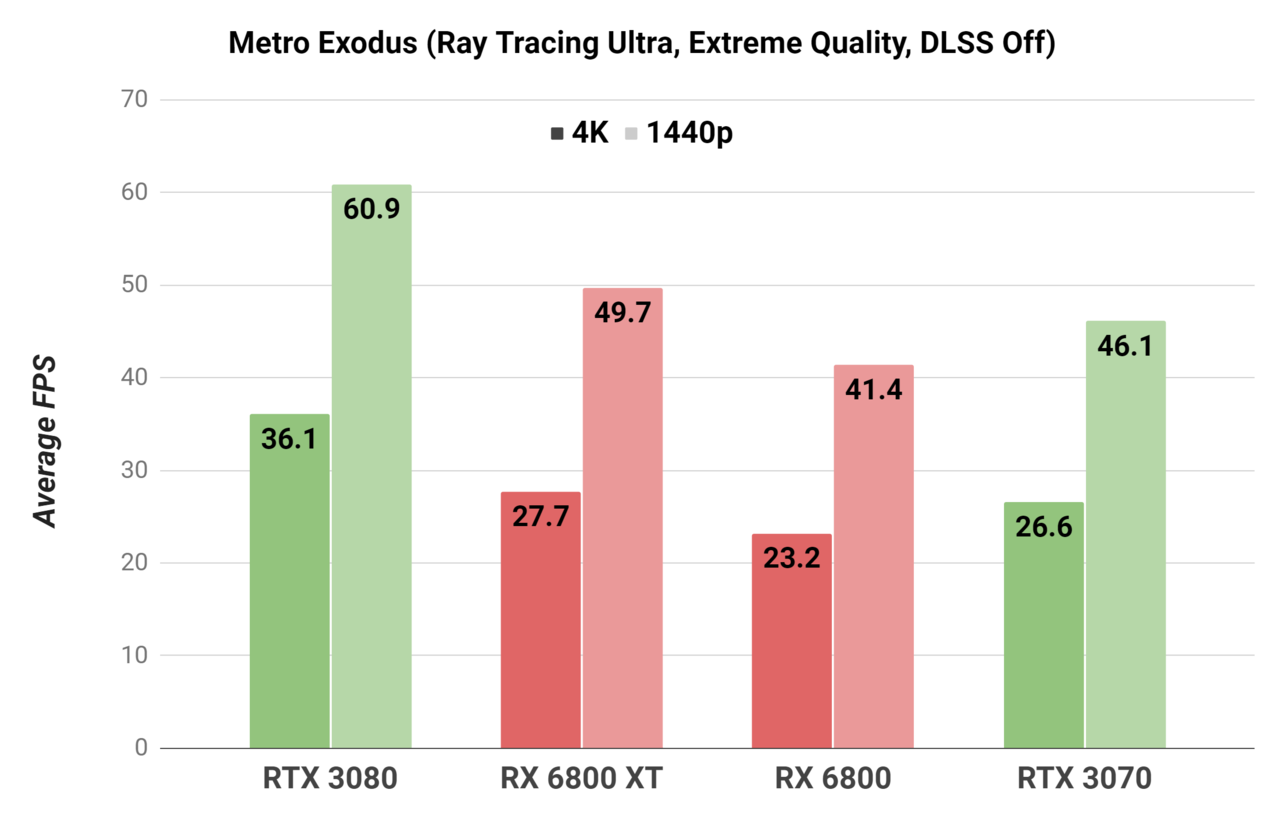
Generally, what you see is that Nvidia's RTX cards hold a steady lead over AMD when it comes to ray tracing. While AMD's new cards are certainly capable of putting out decent performance with ray tracing enabled, they struggle to keep pace as they aren't as well-equipped to do it. It's evident in the performance numbers when you disable ray tracing--here, AMD closes the gap, big time.
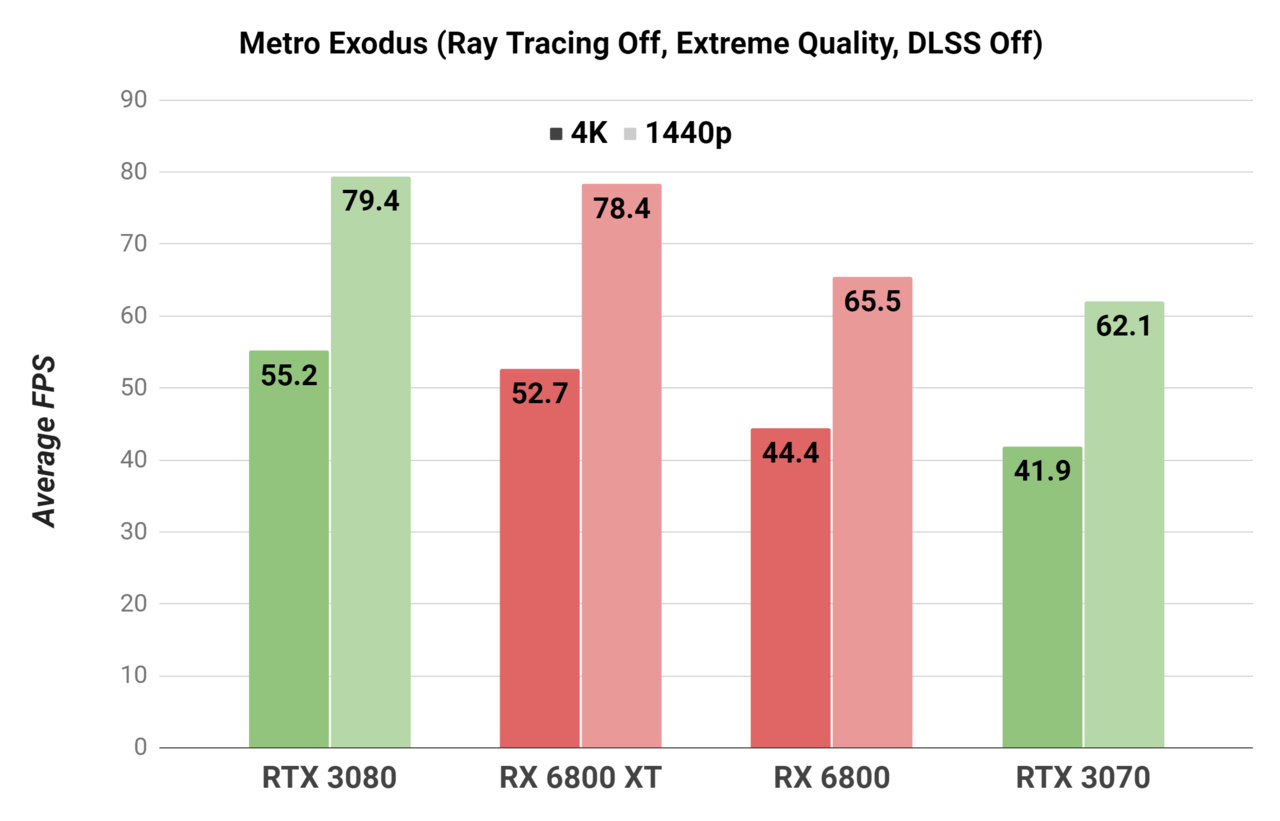
Without ray tracing, the RX 6800 XT is just behind the RTX 3080 by a slight margin, while the RX 6800 overtakes the RTX 3070--and these differences scale accordingly between 4K and 1440p. When you consider the price differences between all these cards, where they land in performance tiers makes sense.
Control
Control is another game that can push video cards to their limits with a full suite of ray tracing features. With every graphics option set to maximum (except MSAA) and all ray tracing options enabled, even the best hardware might not be enough. However, benchmarking the game does produce interesting results.

Like Metro Exodus, you see the Nvidia RTX cards pull ahead in Control with ray tracing features enabled. The RX 6800 XT lags behind the RTX 3080 by a significant margin in both 4K and 1440p, and the RX 6800 trails the RTX 3070 as well but to a lesser extent. Again, Nvidia is better equipped for ray tracing it would seem--but like in Metro Exodus, the gap closes when ray tracing is turned off.

With all quality settings still at their maximum but with ray tracing disabled, the AMD pulls up--the RX 6800 XT is basically neck-and-neck with the RTX 3080, and the RX 6800 overtakes the RTX 3070. This generally aligns with price-performance tiers of each card.
The Thing About Nvidia: DLSS
There is one major caveat to the cases of Metro Exodus and Control, however. Both games feature DLSS, and as previously mentioned, it's a specific advantage for Nvidia RTX video cards. DLSS is sort of the great equalizer when paired with ray tracing, helping boost frame rate to offset the demands of ray tracing while producing native resolution image quality. Based on our tests, DLSS boosts frame rate by roughly between 45% to 54% at 4K--needless to say that these are huge gains.
Games with Nvidia-supported ray tracing will often include DLSS, so if you have an RTX card, it’s often the case that you could use them simultaneously--recent examples being Watch Dogs: Legion and Call of Duty: Black Ops Cold War, not to mention the highly-anticipated Cyberpunk 2077 as well. So while the RX 6800 XT and RX 6800 are able to go toe-to-toe with their competition when DLSS and ray tracing are both out of the picture, Nvidia simply has this advanced (and advantageous) tech on lock for now.
Raw Performance
Support has been growing for ray tracing, but the majority of current games have yet to adopt it, as is the case with the following games used as benchmark tests. In these cases, the RX 6800 XT and RX 6800 assert themselves as powerful cards, sometimes overtaking their Nvidia equivalents.
Godfall
Regardless of where you stand on the overall quality of Godfall, there's no denying that it's visually impressive--one of the truly new-gen games from a graphical standpoint. It's a console exclusive to the PS5 and its PC version makes for a good benchmark for a new era of video cards.
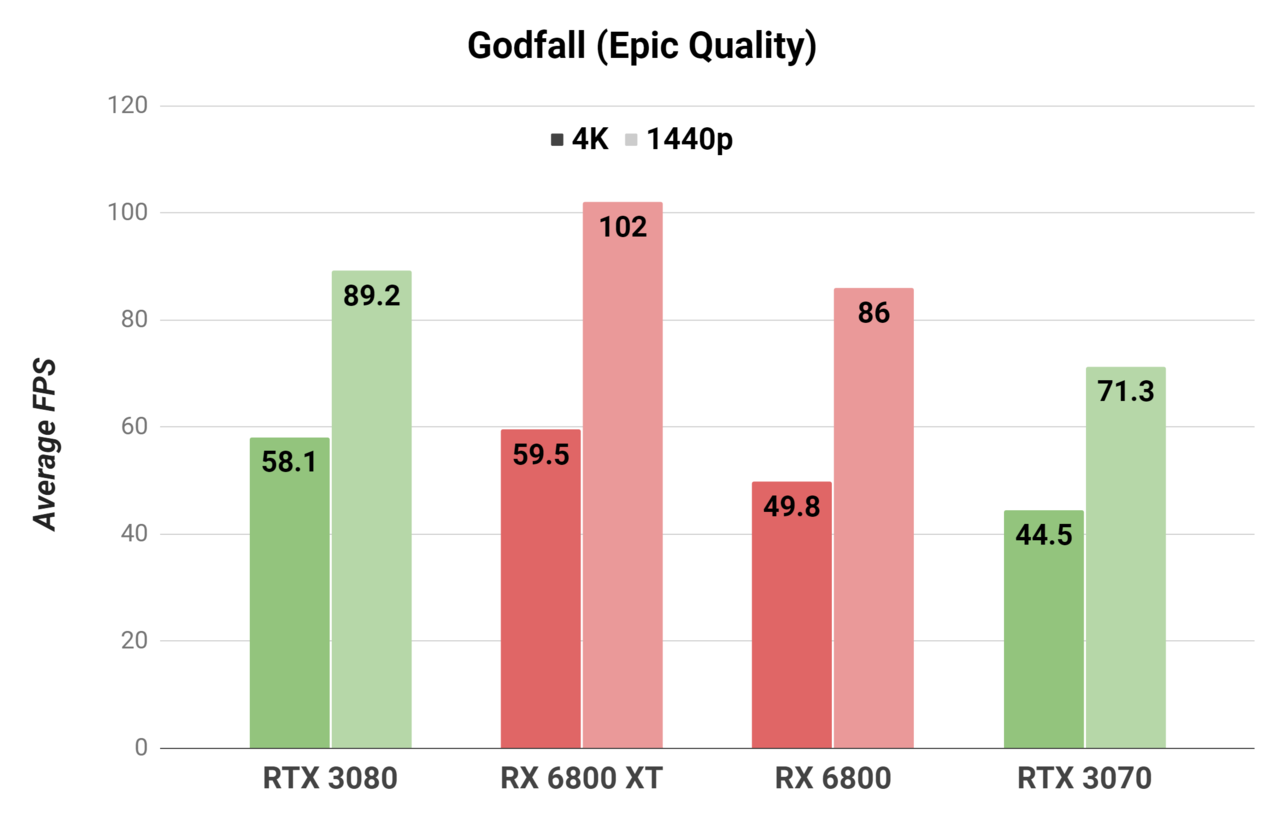
This is a game that's optimized for Radeon cards, and you can see in our results that the Radeon 6800 XT pulls ahead of the RTX 3080 at 4K by a slight margin, but significantly widens the performance gap at 1440p. The same can be said about the RX 6800 when compared to the RTX 3070. But there's something to note here with the RX 6800--its performance at 4K is positioned as you would expect, but at 1440p, it starts to shine and comes really close to the RTX 3080.
Editor's Note: Godfall received a patch on November 18, 2020 that added DXR ray tracing options. Our testing took place before the patch was released.
Assassin's Creed Valhalla
As the first entry in the Ubisoft franchise for next-gen hardware, Assassin's Creed Valhalla can be a really impressive visual showcase. Using the PC benchmark and everything set to "Ultra High," you see results favor AMD cards even more so than in Godfall.

At 4K, the RX 6800 XT comes out on top and hits an average of 60fps while the RTX 3080 trails behind with 55fps. Even the RX 6800 comes close to Nvidia's high-end card and stays well-ahead of the RTX 3070 at this resolution. At 1440p, AMD sails right past Nvidia in a big way--the RX 6800 XT has a 22.4% increase over the RTX 3080, and even the RX 6800 outclasses Nvidia's best by 7.9%. AMD is unmatched at 1440p here.
Red Dead Redemption 2
We reconfigured our Read Dead Redemption 2 benchmark from previous tests, now using the maximum preset graphics settings in the menu (which still leaves out some features, but it's fine because the game still looks stunning).
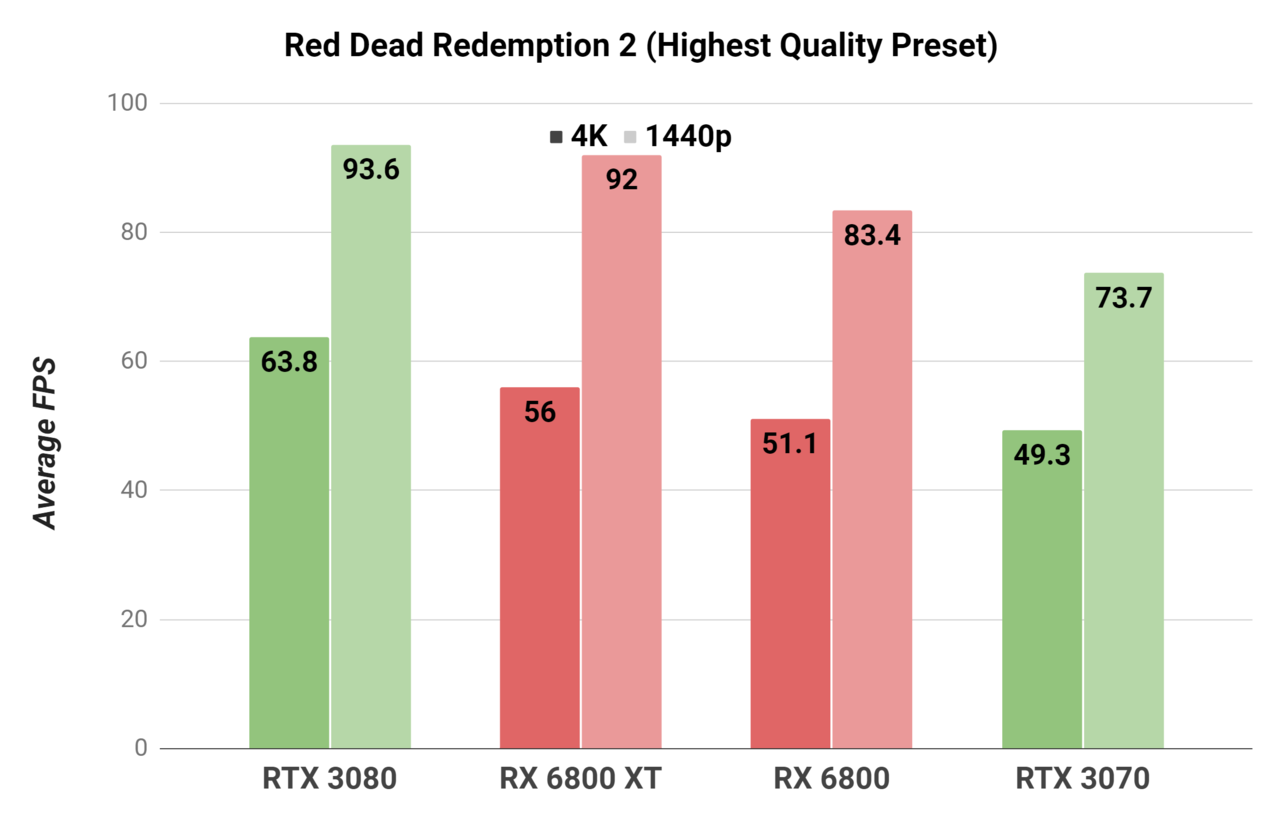
In simple terms, our results show each card falling in line with their expected price-performance tier. At 4K, the RTX 3080 comes out on top quite easily (surpassing a 60fps average) with the RX 6800 XT trailing by a noticeable margin and the RX 6800 barely holding a lead over the RTX 3070. However, AMD has a stronger showing at 1440p again--the RX 6800 XT performs almost on par with the RTX 3080, and the RX 6800 increases its lead on the RTX 3070.
Dirt 5
Dirt 5 is another game that's part of the next-gen console push, and in the PC version, you see it can be quite graphically demanding. With every option set to "Ultra High" using native resolutions, the benchmark results heavily favor AMD, which makes sense as it's an AMD optimized game.
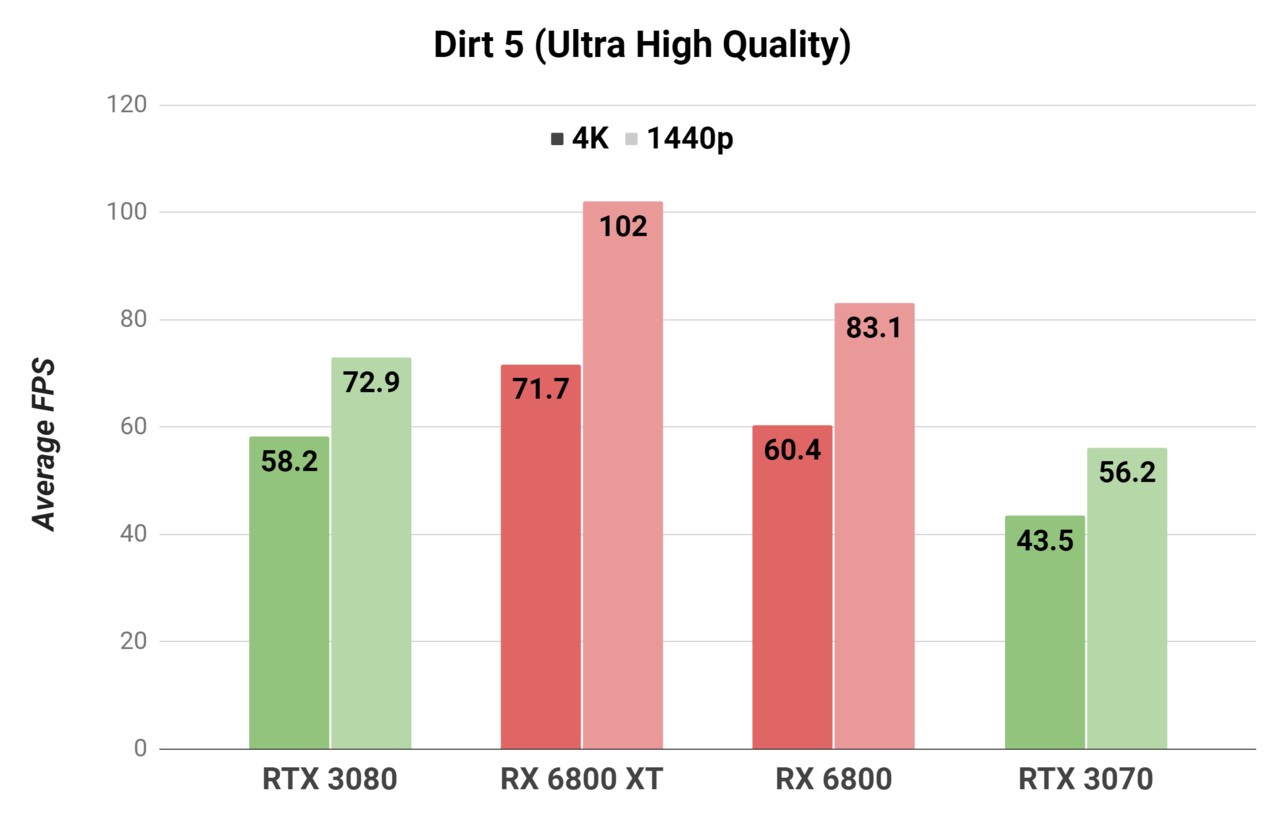
It doesn't need much explaining but the RX 6800 XT earns a significant 23.2% lead over the RTX 3080, and even the RX 6800 maintains a small 3.8% lead over Nvidia's top-end card. At 1440p, the gap in AMD's leads widened with both new cards leaving the RTX cards in the dust--the RX 6800 XT and RX 6800 have 40% and 14% gains over the RTX 3080, respectively. Not bad for cheaper video cards.
Final Fantasy XIV: Shadowbringers
Final Fantasy XIV isn't graphically demanding, but it is the best MMORPG (and RPG, if you ask me) in recent memory. It also exhibits how these high-end video cards fare in low-spec games.

The Shadowbringers benchmark brings things back down to earth as each video card sort of falls within their price-performance tier. At 4K, the RTX 3080 maintains a noticeable lead with the RX 6800 XT following suit. The RX 6800 also only has a very minor lead on the cheaper RTX 3070. The results scale accordingly going to 1440p, but at that point, the game becomes much more CPU-bound.
Horizon Zero Dawn
Horizon Zero Dawn can be a great looking game (aside from its handful of bugs on PC) and its benchmark is a good test for straight performance.
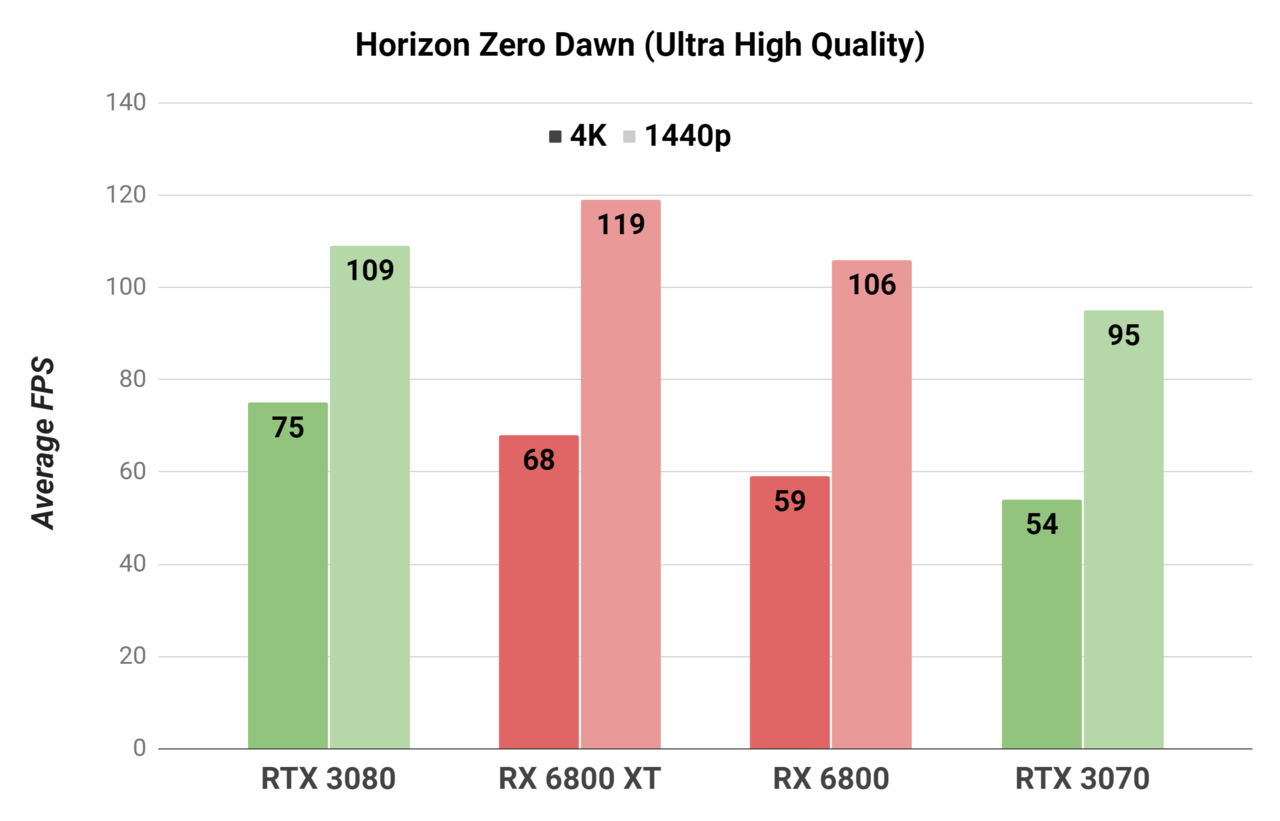
At 4K, the results again show each card lining up the way you'd expect, and both the RX 6800 XT and RTX 3080 are able to break a 60fps average. But the results at 1440p are much more interesting--the RX 6800 XT pulls ahead of the RTX 3080 by a decent margin, and the RX 6800 isn't too far behind.
Forza Horizon 4
Forza Horizon 4 is still a tremendous-looking game, especially when you crank all of its graphics options to their maximum. The detailed benchmark tool is a nice test, and here, it's results share similarities to what you see in Horizon Zero Dawn.

There's nothing too surprising at 4K, with the RTX 3080 slightly ahead of the RX 6800 XT, but oddly the RX 6800 and RTX 3070 are identical. At 1440p, the tables turn again with the RX 6800 XT overtaking its Nvidia counterpart--however, at these frame rates, the differences may not be that noticeable.
Verdict
It's been a while since we could seriously recommend an AMD video card for high-end PC gaming. The RX 5000 series and the RX 500 series offered solid mid-range options during their time, but AMD sort of conceded the high-end to Nvidia.
Nvidia is ahead of the game with ray tracing, which is as expected given they've had two generations to iterate on its RTX platform. It's good to see AMD hold its own with DirectX ray tracing, but the RX 6800 XT and RX 6800 are simply outclassed in this regard. Not to mention that Nvidia's DLSS is one of the most impactful features we've seen in graphics tech in a long time--it's what basically makes games playable at 4K with ray tracing enabled. More games are adopting these features as developers become more familiar with them, and hopefully AMD can provide their own equivalent in due time.
But for AMD's comeback to high-end GPUs, it's showing a lot of promise by making a strong statement in raw performance metrics. In many cases, the RX 6800 XT is suitable for full native 4K gaming, either just trailing slightly behind the RTX 3080 or exceeding it, depending on the game. And at 1440p, we see both AMD cards scale their performance better than the Nvidia cards do. That makes the RX 6800 an appealing card, too--although it's more expensive than the RTX 3070, it can even stand up to the RTX 3080 in a handful of games.
Choosing a video card comes down to what you expect out of your gaming PC. If ray tracing is appealing to you, alongside the prospect of using DLSS (which should excite you if you have a 4K display), Nvidia has you covered with the RTX 3080 or RTX 3070 at $700 and $500 MSRP, respectively. But if you simply want high frame rates at 4K, or 1440p especially, with maxed out graphics settings, the RX 6800 XT looks really nice at $650 MSRP. The RX 6800 at $580 MSRP isn't so bad either, but if you have room to spend a little extra, you'll want to go with the XT version. Those with Ryzen 5000-series CPUs or are looking to build a Ryzen-based PC, keep in mind that AMD's Smart Access Memory may offer some meaningful performance boosts.
Finally, there's some good competition in the GPU space for high-end PC gaming. And it's not just about AMD keeping Nvidia honest, there's a real choice to ponder if you're in a position to consider spending $500 or more on a video card, which sure is a lot of money these days. Either way, in this price range, you'll be getting great performance for PC games.
More broadly, the Radeon RX 6800 XT and RX 6800, and the RDNA 2 architecture they're built on, prove that AMD is actually back.
